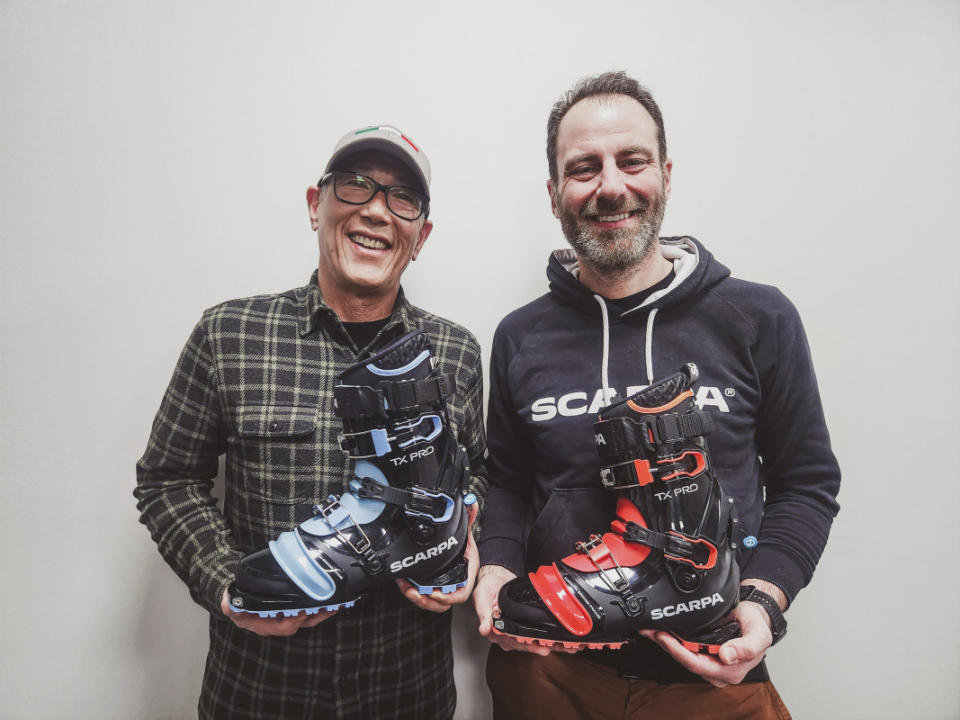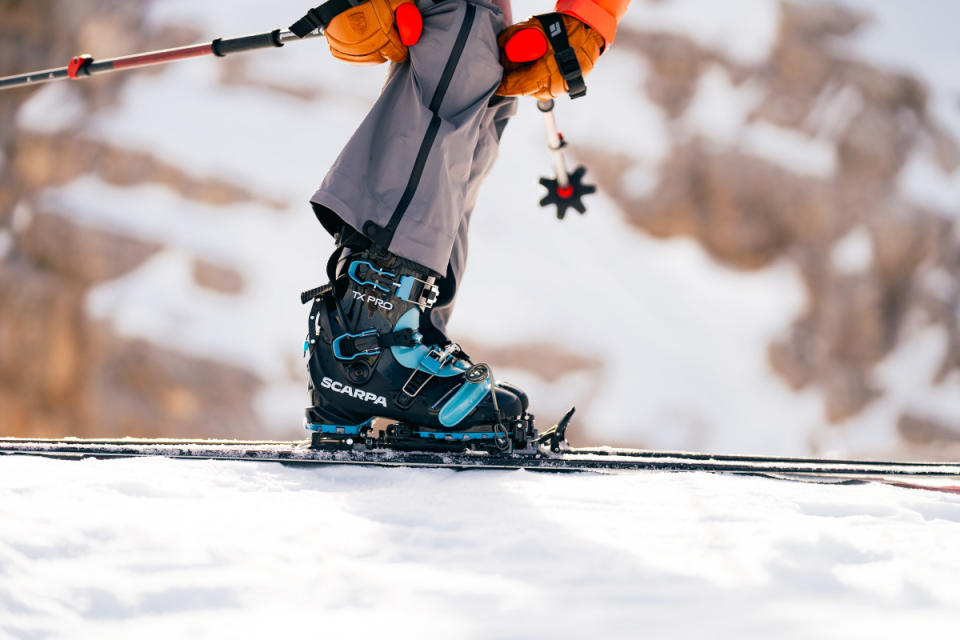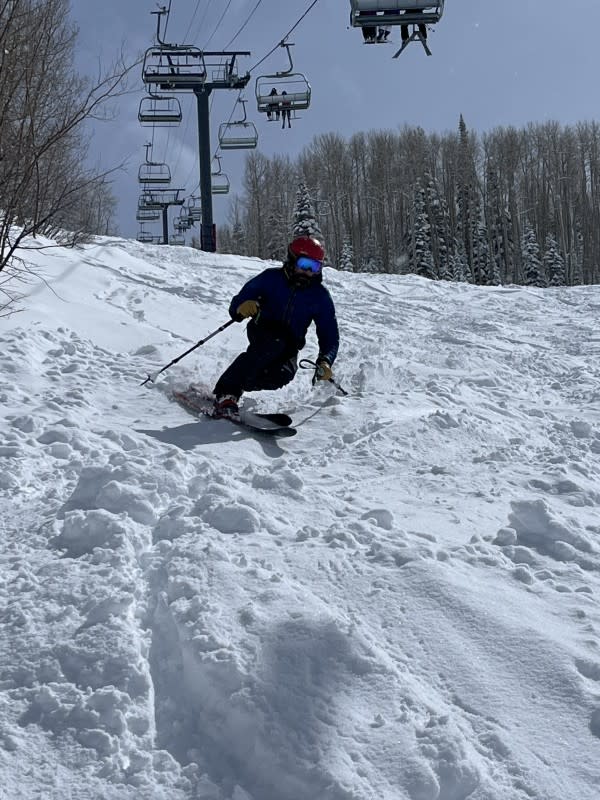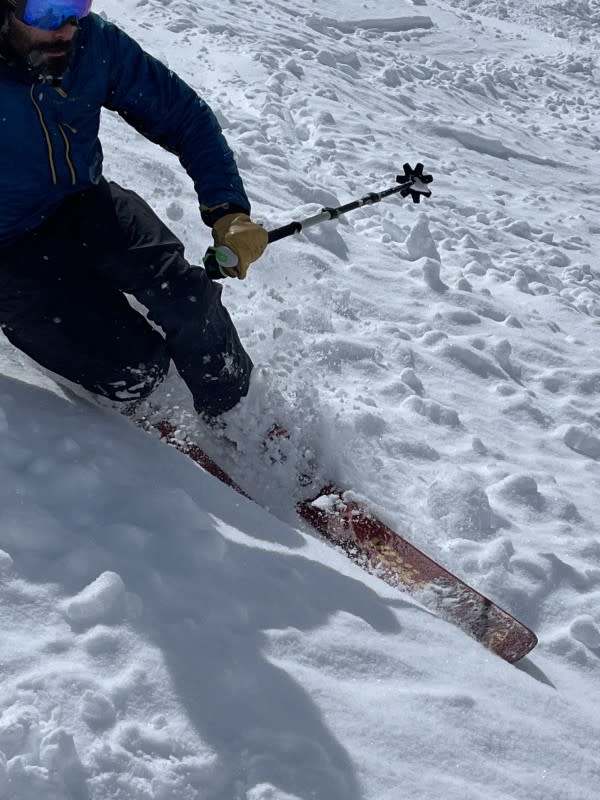Review: Scarpa TX Pro
Powder aims to feature only the best products and services. If you buy something via one of our links, we may earn a commission.
To put it plainly, this is the moment telemark skiers have been waiting for. And they have waited for years.
After what feels like a lifetime of conjecture and rumor, Scarpa finally announced in February that they will indeed release the long-promised, long pined for modern telemark boot – a vastly revamped TX Pro – in the fall of 2024.
And its significance can hardly be overstated. The sport of telemark has been declared dead and irrelevant in preceding years, derided - often unjustifiably - from within and without for its threadbare vibe and dwindling gear options. Still, telemark has often seemed to get by on the slimmest of margins. As the sport has fought for relevance, participation has dwindled, and the bigger companies have - one by one - left telemark behind.
But ebb has since turned to flow – more skiers seem to be taking to the telemark while an energy in the scene appears to be building. And Scarpa’s new Tx Pro signifies a watershed moment in the sport’s long-coming modernization. It marks not only telemark’s survival into a contemporary paradigm, but sets a path for a future of further development.
To talk to Scarpa North America CEO Kim Miller about the new Tx Pro is to get the sense that both soul and business luckily aligned to make the new boot a reality. And Miller gives a similarly dichotomous vibe – at once a practical and able businessman, Miller also counts himself amongst the heady cadre of long-time telemark skiers.
“I started in leather boots - I don’t even want to give you the details,” Miller says playfully, “I was like a telemark dinosaur in some ways, but it informed me every step of the way.”
Both Miller and Scarpa have had a long presence in telemark, and those deep roots have laid a foundation that few other entities in the space boast. Scarpa was the first to introduce an all plastic telemark boot - the Terminator - in 1992. And since then the firm has solidified itself as the leading manufacturer of free-heel footwear. Scarpa was on the forefront of Rottefella’s introduction of the New Telemark Norm in the mid-2000s, and continues to sell more telemark boots than any other manufacturer by an order of magnitude. No other company has so embodied boot innovation in the scene over the years, and no other company has been relied on as heavily by the throngs of die hard free-heelers as the Italian manufacturer.
Thus rumors and high expectations have swirled for years. Scarpa has tinkered with the concept for the better part of a decade, each season leaving the telemark world teetering on the edge of their seat as they’ve waited for official news that a new boot would soon be released that rivaled alpine touring equipment in weight, range of motion, and features - attributes telemark boots have long lagged in.

But while telemark footwear was long ago relegated to older technologies, only recently did Scarpa feel that the time had arrived to make a move toward a modern boot.
“There always needs to be a business case, but how you spin that can be really different for different products or in this case different brands” says Miller. “So why now? Let me first say that the telemark skiing community has been hungry for a new boot and bugging us for years, so that’s always been in the top of our mind, not the back of our mind,” Miller says with a laugh.
With that, Scarpa took to years of testing and research, utilizing both a European and North American group of testers - a corps that includes not only strong skiers, but industry scions. In that time telemark bindings entered a sort of golden era of tinkering and innovation, incorporating Dynafit-style tech toes, while the New Telemark Norm finally found ascendancy over legacy 75mm gear in the hearts and minds of (many) skiers.
That left some variables at play “because of the quirky nature, because of all the do-it-yourself stuff,” Miller says, continuing “the discovery part of a new design is really tricky when you’re looking at new bindings that didn’t exist a few years ago.” After some shaking out - and some protracted development - the time finally came to release the new boot.
“What made it possible for us to do this this year was it took a while to design a new boot, and to really be thoughtful about what we were doing, and to cut new tools – that’s a big investment,” Miller explains. “Just for the record a new line of boot molds costs about, for a size run of boots, is about a million dollars. So you definitely want to have a good case for why you want to do this. So we first have to build the business case,” he says.
That case was made in part on Scarpa’s dominance in the telemark boot industry.
“It seems like a very small market, that’s certainly how it appears,” says Miller. “But here’s the deal – it’s not just about the size of the market but it’s about the market share from a business case perspective. We’re basically the only ones doing telemark boots – there’s a few other brands out there doing it but I’d say not to the level and not the sales to the level we have. So small market but big market share is the relationship that makes it economically viable, if I can be so bold to use that term,” Miller says laughing.
On the design end, Scarpa was challenged by not only the changing scope of binding interfaces, but also the endless continuum of skier preferences - and the singularity of the new release meant trying to bring to market a lone boot that could satisfy many if not most skiers.
“A telemark boot has one very unique thing - it has to flex and be stiff at the same time. It has to have this forward-aft bellows flex, but it has to retain torsional rigidity, and the flex is tricky to dial in,” says Miller.
While many of the features of the boot were easily incorporated from other Scarpa lines - including the ski/walk mechanism and pebax construction, the flex of the boot - especially at the bellows - became the paramount variable as testing moved forward.
“The biggest thing we adjusted was the flexation. The durometer, the stiffness of the plastic in the bellows, the rest we pretty much nailed it in the first try,” says Miller.

What’s come to pass is the most modern telemark boot yet brought to market. No other boot has so incorporated modern features - especially for touring - as the new Tx Pro, ever closing the weight and feature gap between telemark and alpine gear.
The new iteration - compatible with the New Telemark Norm (NTN) and the touring-oriented Telemark Tech System (TTS) - boasts a weight of 1545g per boot for a men’s size 27, and 1360g per women’s 25, cutting weight by 11 percent for the men's line and 14 percent for the women’s at the respective list sizes. The new model continues the Tx Pro’s lenient 102mm last, with men’s sizing ranging from 24.5 - 31 mondo points, women’s from 23 to 27. Though the current boot sole lengths are close to a full centimeter shorter than the previous Tx Pro’s sizes, skiers will find consistent fit at their usual Scarpa mondo point.
The three buckle boot reverts back to the T2-style ratchet strap over the instep, locking the heel in securely, and incorporates a large power strap at the cuff instead of a fourth buckle. Much of the componentry is attached with screws and is thus replaceable, including the strap, instep buckle, bellows guard, and tongue, a welcome feature for longevity, that may pique the interest of a DIYer or two.
The comparatively thinner, lighter, and more malleable Intuition liner includes added flexibility where the bellows pivots over the forefoot. Weight has also been saved at the heel of the shell, with the new Tx Pro having a more svelte rear. And the walk mode of old - a heavy and dated contraption - has been updated to the sleek version used in Scarpa’s stalwart AT boot, the Maestrale, offering ample range of motion in walk mode, snapping into a singular position for descent.
Though the boot includes an updated tech toe interface, the new Tx Pro remains incompatible with alpine touring heels - like can be added to InWild’s Meidjo. Scarpa chose not to incorporate rear tech fittings due to liability issues with a boot that can cross over between the alpine and telemark norms.
“We fall under the same umbrella of liability concerns that anybody in the ski business does now. And when you talk about boot-binding interface and systems interface, that’s the number one area where problems occur,” Miller says.
Still, some hope remains for those wishing for one boot to do it all from Scarpa - something Miller has long called his one-boot, one-world philosophy, a notion he first picked up when he helped launch the first edition of the F1 nearly twenty years ago, a bellowed alpine touring boot that has since become the darling of telemark DIYers of the touring persuasion.
Speaking to the dearth of telemark boots that are compatible with an alpine heel (no manufacturer except Crispi includes that hardware on their NTN boots) Miller gives a tantalizing crumb, “that’s a consideration that’s being worked on in Europe because Meidjo’s a pretty popular binding in Europe, not as popular here.”
So the route forward (for now) from Scarpa is strictly focused on telemark compatibility - including new all-mountain, touring models like the Tx Pro.
As telemark bindings have reached revolutionary weights and features, allowing a breadth of options, innovation in the boots had long lagged, especially in regard to touring specs. What the new Tx Pro (and the bevy of new, innovative touring bindings) promises is a telemark future not of endless sacrifice in weight and other penalties, but of gear that achieves parity at least with mid-weight AT equipment.
And who knows how much lighter future telemark gear could be? One day the only difference between the disciplines may be the fact that one system allows for a telemark turn.
But how does the new Tx Pro tour and ski?

The newer vanguard in telemark equipment has unavoidably reached across the aisle to the world of alpine skiing for innovation. Long have telemark skiers compared specs with their alpine brethren and been disappointed at the heavy, ROM-lean nature of their own gear.
While these boundaries have slowly come down - with the new Tx Pro bridging that gap in part by borrowing from Scarpa’s AT offerings - the operative sensation in the gear has also evolved. As lighter and more aggressive skiing options have come to telemark equipment, the gear has become more efficient, adept and also more rigid. While it may offer less freedom of flex, the edge transmission on NTN gear is unarguably stronger than duckbill equipment. And the touring capability of the newer telemark platforms is similarly lightyears ahead of the sweet flexing but inefficient world of 75mm turn-earning.
The new Tx Pro finds itself firmly in the high-performance, rigid paradigm on descent, while ushering in a new era in telemark touring capability.
Paired with an NTN tech binding or a Telemark Tech System, the new Tx Pro tours with an efficiency that no other plastic telemark boot has ever seen at retail. Besides the huge weight reduction and Dynafit capability, the most striking efficiency on the new model comes in the range of motion via the vastly improved walk mode borrowed from the Maestrale.
Telemark boots have long not just been heavier than alpine touring counterparts, but have also come with uncompromising inflexibility in walk mode. The 62-degree range of motion in the new Tx Pro is a revolutionary step for telemark touring boots, especially considering many available SKUs have rearward mobility of 15 degrees or less - which the new Tx Pro easily bests at around 25 degrees. And this attribute brings a rare equivalence with alpine touring equipment - the Maestrale lists range of motion at 60 degrees.
The lighter weight and range of motion marks a long-sought improvement for those coming from current NTN boots - and may amaze tourers who prefer 75mm gear. No other boot on the market offers such comfortable touring, with the rearward range of motion granting a newfound ease for earning telemark turns. It’s an improvement in efficiency that few outside of the new-old-stock and DIY telemark worlds have experienced, and absolutely marks a paradigm shift in off-the-shelf telemark touring gear. Telemark touring boots have officially entered a new and exciting stage.
Speaking of the DIY cohort, the 2025 Tx Pro will be a welcome retail-available touring boot for those who have enjoyed the old stock Scarpa F1 and F3s - bellowed alpine touring boots manufactured in the mid/late aughts long used by touring-minded telemark skiers. At 1545g per boot at size 27, the new model is nearly identical in weight to the F3s (though the 2025 Tx Pro offers much more range of motion) while the old stock, bellowed F1s clock in around 1340g (depending on the model), about 13% lighter than the new Tx Pros at the same size. The two boots have a similar range of motion, though the old F1s are not as durable, certainly not as available, and offer a much softer flex on descent.
A new day for touring capabilities in telemark boots has dawned - especially as a plug-and-play, retail-ready option.
That brings us to the downhill capabilities of the new Tx Pro.
The new, lighter construction - notably the triple-injection molding in the scafo, which includes a frame providing torsional rigidness before an outer boot shell is molded over - gives an evermore modern telemark turn. Instead of the suppleness of 75mm and Scarpa’s current NTN boots, the new Tx Pro is a contemporary, more rigid and aggressive model.
The outer shell’s connection at the scafo is firm - pushing the shin forward into the cuff comes with a high resistance, even compared to many current NTN boots, and this stiff flex is paired with a soft bellows. While the skiing sensation marks a departure from legacy plastic telemark boots, the firmness of the flex at the shin coupled with a forgiving bellows lends itself to a taut efficiency. With most of the pivot focused over the forefoot, the new boot ushers the skier toward a more compact and upright stance that many modern aggressive telemark skiers take to, seeming to require less effort toward each lead change.
As such a deep lunge is not as practicable on the new boot (though not impossible). And aggressively weighting the back foot is not as tolerable on the new Tx Pro as it is on softer legacy boots. But the new boot allows an active and aggressive skiing experience in line with the modern paradigm of telemark - and the boot enjoys fast, long radius turns down the fall line, and skis aggressively and well in soft snow.

The flex of the new boot will be a welcome addition for those who ski with an upright position and who enjoy boots on the stiffer side. While the new Tx Pro is eminently skiable, there will undoubtedly be a learning curve for those used to a more limber boot and a softer sensation in the turn. Over-leveraging the uphill ski can be a problem for those used to leading hard with the back foot, but once that notion is withdrawn, and the skier yields to the boots stiffness, things fall into place. Barely a drop of the knee is necessary for the uphill edge to engage, leading to an efficient, upright telemark with a straighter front leg. It marks a different style than soft boot telemark skiing, and one that nudges the skier toward using the front foot more.
The new Tx Pro and its novel construction marks a departure from the older paradigm of heavier and softer iterations in telemark gear - bringing telemark boots into a new world on ascent and descent, where revolutionary uphill specs and a new, rigid flex pattern have been utilized.
Like anything related to telemark gear, the preferred flex is full of personal nuance for each user. With its lightweight construction, forgiving bellows, and aggressively stiff sensation at the cuff, the new Tx Pro is an apt pairing with contemporary bindings - especially those tuned to an active setting, taking to fast, long turns well. Though those looking for a deep lunge and supple flex may be steered away from their typical turn, adapting to the boot’s rigidity is certainly not out of the question and may take only a few times out to crest, if the user finds a learning curve at all. Though the sensation of old may be lost in the process, adaptation is absolutely possible, and may be desirable for many skiers.

Music to free-heel skier’s ears ensues:
“We think about actually developing the telemark line in both directions, so even to the light side, [and] to the heavier, stiffer - like the Tx Comp - side. Those are on our whiteboard of design and we’re noodling on that,” Miller says.
Broader than how this one model may ski is that the supposed dormancy of telemark - culture, vibe, manufacturing, and all - may indeed have been a myth all along. And any notion of telemark’s death was perhaps what it always seemed to be: exaggeration and distraction.
The new Tx Pro brings about a new standard in telemark touring specs while pushing the downhill realm more toward the modern paradigm. It tours better than any telemark boot to date, and skis well - for many it will be out of the box, for others - especially of the softer boot persuasion - after a short learning curve.
And though this boot now bears the weight of being telemark’s lone footwear savior, it soon may not have to hold that burden alone. The new Tx Pro is a start in an exciting new direction for telemark equipment, and is a suitable boot for what it’s designed to do - tour and descend.
Telemark lives on, as does a path forward for Scarpa’s telemark boots - long amongst the most important gear in all of free-heel skiing.

